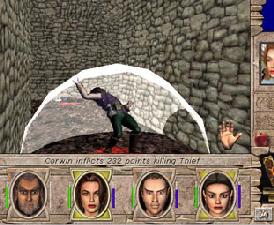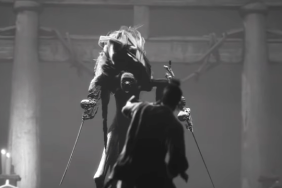Just two more sequels and we’ve caught up to Ultima!
The kingdom of Enroth is in trouble once again. King Roland Ironfist is ill and the queen’s father, Nicolas Gryphonheart, has been killed and brought back as a lich-king. Archibald Ironfist, evil brother of the king and disposed of in Might and Magic 6, has returned to claim the throne that is ‘rightfully his.’ The dastardly brother has taken control of the guild of necromancers and is planning his takeover of the kingdom. Once again it’s up to a bunch of unproven adventurers to defeat the evil empire of darkness and return order to Enroth.
Might and Magic 7 continues the tradition set by its six predecessors – classic Dungeons and Dragons style role-playing played through a first-person perspective. You customize and take command of four adventurers, and the computer takes care of all the dice-rolling, map-drawing, note-taking and number-crunching.
This time around there are more options than ever before. Your characters can be cast as humans, dwarves, goblins or elves – each having specific characteristics. Characters also have an occupation, be it knight, thief, monk, paladin, archer, ranger, cleric, druid, or sorcerer. Again, each occupation has it’s own perks and drawbacks. Finally, each occupation advances to different levels, which differs a bit from the standard level advancement through experience points. By completing certain quests, your knight can become a cavalier. Then, depending on a certain decision you make in the game, your knight can become a champion or a dark knight.
Might and Magic 7 uses the skill system found in Might & Magic 6. Your characters can learn skills such as bodybuilding, plate armor, swords, axes, disarming traps, etc. As you gain levels, you are allotted points that can then be allocated towards advancing these skills. Obviously, the higher the level of skill your character has, the better he or she can perform the skill.
Combat and adventuring is also the same as in Might and Magic 6. Combat can be either turn-based or real-time; simply pressing a button switches modes. Casting spells and attacking is done by moving a target around and clicking buttons. Walking around is just like in Quake or Doom, though this time around there’s 3D acceleration so the framerate is quicker and the graphics are smoother.
Another thing that hasn’t changed is the interaction with NPCs (the people of Enroth). Most of the important people are found inside houses, and entering a house automatically brings up a dialogue box. Basically, you never get to walk in a house and explore it. Rather, you only enter houses to talk to people or perform business. And the conversation (if you can call it that) consists of selecting from a short list of key words that is always responded to in a brief, concise paragraph of text. It’s not very immersive, to say the least.
Thus, much of the game is focused on combat and adventuring (mostly combat, though). This is the downfall of the game. Combat in role-playing games is expected to be a regular occurring experience, but it should not be something that brings dread and feelings of tedium to the player. In Might and Magic 7, you constantly attack monsters, run away to rest, and then return to pound away the rest of them. In-between fighting you stop to buy new weapons, spells, and upgrade your skills. I don’t believe there is a quest in the game that doesn’t require combat to complete.

Actually, there is one quest that doesn’t require combat. That’s the interesting game-within-a-game called Arcomage. Arcomage is best described as a simplified rip-off of Magic the Gathering. Your characters can find a deck of Arcomage cards by going in a dungeon and fighting monsters. Then they can play against the computer in the different taverns throughout the land. In Arcomage, your goal to either build your tower to a certain height, kill the enemy’s tower, or accumulate a certain amount of resources. You draw cards that represent monsters, spells, or artifacts and they are used to produce varying effects. It’s easy to play, requires a certain level of strategy, and is definitely a welcome break from combat. Not a bad idea at all.
The differences between M&M 6 and M&M 7 are subtle and far between. The graphics have improved, but very slightly. The 3D environment is pretty much exactly the same. The monsters look a little better, but are still pixelated and just horrible when seen up close. The difference in speed due to the 3D acceleration is negligible at best.
There are some gameplay enhancements that I liked. For one, the guards in the towns actually fight monsters that enter the city limits. Also, the different kinds of monsters actually fight each other in the dungeons. The variety of skills, character classes, spells, and overall number of customizations is also nice.
But overall, Might and Magic 7 just doesn’t make enough advancements over Might and Magic 6. It’s basically the same game with a slight makeover and tweaking. If you loved part 6 and want some more of the same, then 7 will do nicely. But for those of you looking for a new experience should look elsewhere, as there’s just not enough pizzazz to keep you interested for long.
-
Plenty of character customization
-
Arcomage is fun
-
Good 'ol fashioned role-playing
-
Might as well be Might and Magic 6
-
Misdemeanor: Excessive combat







